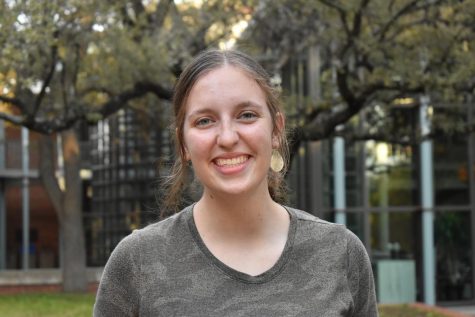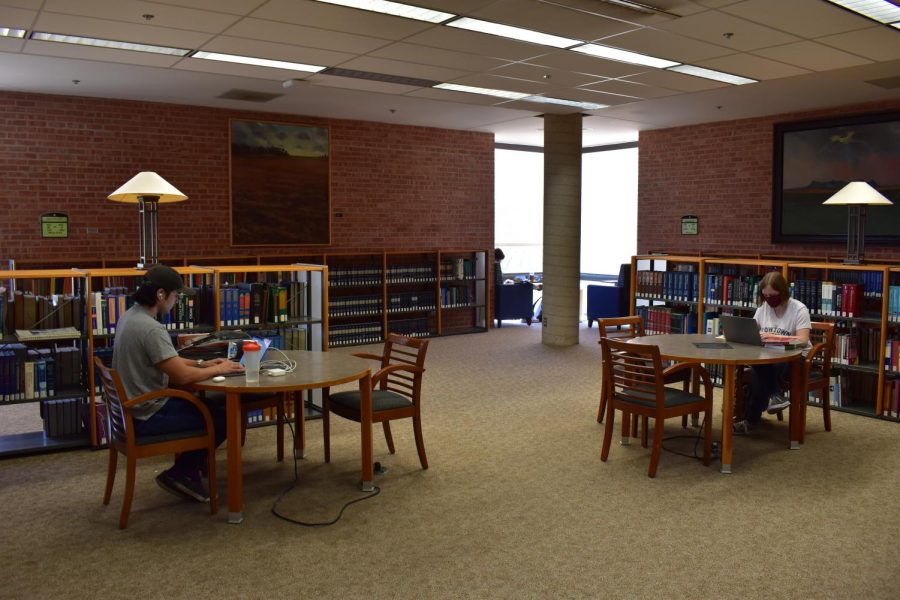Mask no more: Professors weigh in on ProtecTU Protocols
New campus policies place masking decisions in hands of staff and faculty members
Students studying in the Coates Library.
On March 7, after over a year and a half of mandatory masking, the ProtecTU mask policy officially changed to optional masking in most indoor spaces. Additionally, as a March 3 Trinitonian news brief outlines, dorm room occupancy expectations returned to pre-COVID guidelines.
The policy changes have come as a result of the TU community reaching the green threshold. As outlined on the campus website, there are less than 10 campus cases per 7-day average, the community risk is low/mild to moderate and the campus vaccination rate is greater than 70%. Marcy Youngdahl, Director of Integrated Counseling & Health Services, discussed the process behind these changes.
“The current ‘indicators and thresholds’ were determined based on the transmissibility and virulence (disease severity) of the Omicron variant,” Youngdahl wrote in an email. “At this level, we have determined that the risk of viral transmission in our TU community is low, and therefore it is safe for us to withdraw certain required mitigation measures such as indoor masks, gathering size limitations and visitor limitations.”
Based on the nationally dropping case rates, high community vaccination and recent infection rates, Youngdahl wrote that she was not expecting a large outbreak from spring break travel.
In a community-wide email, Interim Vice President of Strategic Communications and Marketing Frank Guerra confirmed Youngdahl’s prediction. From March 14 to March 24, there were 6 positive tests out of 179 tests performed. This number keeps within the green level indicator of less than 10 campus cases per 7-day average.
Additionally, Youngdahl said that the new “sister strain” of Omicron (BA.2) does not seem to be more vaccine-evasive or virulent than Omicron (BA.1), but that the COVID Response team will continue to monitor the situation closely.
However, there are exceptions to the optional nature of the policy: faculty and staff may require masks in personal offices or classrooms. Charles B. White, a professor of psychology at Trinity for over 40 years, weighed in on the policy changes and the effects on his classroom environment.
“I’d say somewhere between 30 and 50 percent of what is communicated gets lost behind a mask. Facial expressions are really important in communication,” White said. “I have 60 students in each of my two sections [of introductory Psychology] … it’s hard enough to know the students, much less to know them when they’re masked.”
White made the decision to adhere to the mask-optional policy of the university during his classes and in his office. David Crockett, professor of political science, made the same decision for his classroom. Crockett cited lower local infection rates and high vaccination rates among students and faculty as reasons for confidence in the policy change.
“The vaccination situation on campus, the lesser threat of Omicron in terms of its virulence — not necessarily getting it, because people have got it, but it’s not as dangerous — and the erratic nature of the mask mandate itself, to me, are good reasons to do away with the mandate under current conditions,” Crockett said.
Other professors have taken a different approach when considering whether or not to enforce mask mandates in their classrooms.
White discussed how some of his other colleagues came to the conclusion to continue to enforce the mask mandate. They gave their students an anonymous survey to determine how the students in the class felt about wearing their masks, letting the students make the decision.
Crockett shared his thoughts about how the policy change leaves the decision regarding masks in the hands of individual faculty members, rather than making it a campus-wide decision. Crockett said that he would not want to prohibit a faculty member that feels uncomfortable without masks from mandating masks in their classrooms.
“On the other hand, by making it sort of quasi-official that it’s up to faculty discretion, the onus then moves to the faculty member to make this decision, and they will inevitably then be petitioned by students who might feel uncomfortable without a mask mandate and then the pressure,” Crockett said.
Although the mitigation protocols have been altered, there is still a possibility that they may change back, according to Youngdahl.
“Trinity’s COVID response team may ask that we return to certain mitigation measures in the future if conditions change,” Youngdahl wrote. “Currently, we do not expect our mitigation measures to result in zero infections or no community transmission. We do expect these measures will keep us operational, prevent large outbreaks and protect the vulnerable in our population.”

Hello, y'all! I'm Abby Power, and I am a sophomore news reporter from Kyle, Texas. I intend to major in Political Science, Spanish, and Global Latinx Studies....

My name is Claire Sammons and I am an Anthropology and Communications double major. I have worked for the Trinitonian since fall of 2020. I became a photographer...






